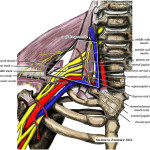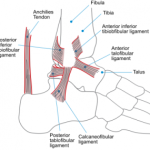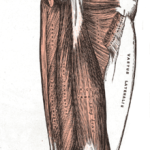Anterior shoulder dislocation is a common injury in an athletic population, particularly young males competing in contact sports. Anterior dislocation accounts for up to 96% of all shoulder dislocations (Goss 1988). This means, therefore, that the sports physiotherapist will encounter this condition with high frequency. Accordingly, we must be confident that the treatments and advice that we deliver to these athletes is evidence based.
This article discusses the current research comparing the use of surgical and conservative (physiotherapy) management of acute anterior shoulder dislocations. It is important to note that I have not compared the particular surgical technique utilised for stabilisation. However, Pulavarti et al. (2009) showed there were no statistically significant differences between open and arthroscopic surgical techniques for anterior shoulder instability.
The main outcomes that I feel is important to assess is recurrence, return to play, and functional outcomes (self assessed or otherwise). I feel this will give some idea as to the overall effectiveness of either treatment, so that we can comfortably suggest either to our patients.
RECURRENCE (RE-DISLOCATION RATES)
A Cochrane review by Handoll et al. (2004) compared the outcomes of surgical stabilisation and conservative management. The systematic review pooled the results of four clinical trials and found a significantly higher recurrence rate in the conservative groups. Yeah, we knew that, but by how much. Well, the conservative group were four times more likely to have a recurrence than the surgical group. Nice. It is noteworthy also that younger males were at a higher risk of re-dislocation.
These findings are mild compared to those of Jakobsen et al. (2007), who compared primary repair (as in first-time dislocators) with conservative management in a randomised controlled trial. The authors found that after a minimum of 2 years’ follow-up, 56% had recurrence after conservative treatment compared with 3% after open repair.
RETURN TO PLAY
The studies are conflicting on this topic (how often this happens in physiotherapy!). Of the articles included in the Cochrane review two (Wintzell et al. 1999; Kirkley et al. 1999) showed similar rates of RTP between the two groups. However, Sandow et al. (1996) reported whilst 90% of the athletes in the surgical group returned to previous levels of sport, only 10% of the conservative group did. Given, this large variance from the other literature these results seem dubious.
FUNCTIONAL OUTCOMES
As you would expect given the above results, the surgical groups seem to consistently deliver better functional outcomes. Jakobsen et al. (2007) showed through use of the Oxford Self Assessment Score that 72% of the surgical group had good to excellent results, whilst 75% of the conservative group had unsatisfactory results. This was due to either pain, recurrence, stiffness, or instability. The systematic review by Handoll et al (2004) also showed statistically significant results in favour of the surgical groups.
AN ARGUMENT FOR PRIMARY REPAIR?
Well, this is the question isn’t it. When these patients arrive in our clinics do we refer to an orthopaedic surgeon and recommend ‘primary repair’ or do we attempt conservative management? The results above suggest that primary repair is well supported, given the superior clinical outcomes. However, Sachs et al (2007) refute the idea of primary surgery. Their study identified high risk groups (young patients, contact sport participants, and those with overhead occupational work) yet found only approximately half of these patients opted for later stabilisation surgery (despite a high re-dislocation percentage). Far out, what do we do?
TAKE HOME MESSAGES
Surgical stabilisation in anterior shoulder dislocations results in:
- Significantly Improved Stability
- Significantly Improved Function
- ? Similar rates of RTP
High risk groups for re-dislocation following conservative management are:
- Young People
- Contact Sport Participants
- Those who perform Overhead Occupational Work
CONCLUSION OF BEST PRACTICE
Surgical stabilisation clearly provides significantly better outcomes. However, conservative management can produce favourable outcomes in some patients. Primary repair should be considered in the identified high-risk groups. Yet, there is some evidence to suggest that trialling conservative management may pay off. If the patient does re-dislocate and wishes to have stabilisation surgery it is worth noting that Grumet et al (2010) found no significant differences in arthroscopic surgical outcomes for first-time dislocators or those with recurrent instability.
My frequent experience, and I’m sure I’m not alone, with conservative management of anterior shoulder dislocations is that the athlete (despite advice) returns to play too quickly and has repeated episodes of instability/dislocation.
What are your experiences – surgery straight up or give conservative treatment a go? Be sure to let me know in the comments or catch me on Facebook or Twitter
Remember – if you require any sports physiotherapy products be sure check out PhysioSupplies (AUS) or MedEx Supply (Worldwide)
REFERENCES
Grumet RC, Bach BR, Provencher MT. Arthroscopic Stabilization for First-Time Versus Recurrent Shoulder Instability Arthroscopy 2010 26(2): 239-248
Handoll HHG, Al-Maiyah MA. Surgical versus non-surgical treatment for acute anterior shoulder dislocation. Cochrane Database of Systematic Reviews 2004, Issue 1. Art. No.: CD004325. DOI: 10.1002/14651858.CD004325.pub2.
Jakobsen BW, Johannsen HV, Suder P, Sojbjerg JO. Primary Repair Versus Conservative Treatment of First-Time Traumatic Anterior Dislocation of the Shoulder: A Randomized Study With 10-Year Follow-up Arthroscopy 2007 23(2): 118 – 123
Kirkley A, Griffin S, Miniaci A, Mohtadi N. Prospective randomized clinical trial comparing the effectiveness of immediate arthroscopic stabilization versus immobilization and rehabilitation in first traumatic anterior dislocations of the shoulder [abstract]. Journal of Shoulder and Elbow Surgery 1999;8(2):181.
Goss TP. Anterior glenohumeral instability. Orthopedics 1988;11 (1):87–95.
Pulavarti RS, Symes TH, Rangan A. Surgical interventions for anterior shoulder instability in adults. Cochrane Database of Systematic Reviews 2009, Issue 4. Art. No.: CD005077. DOI: 10.1002/14651858.CD005077.pub2
Sachs RA, Lin D, Stone ML, Paxton E, Kuney M. Can the need for future surgery for acute traumatic anterior shoulder dislocation be predicted? The Journal of Bone and Joint Surgery (American). 2007;89:1665-1674
Sandow M, Liu SH. Acute arthroscopic Bankart repair for initial anterior shoulder dislocation: A prospective clinical trial [abstract]. Journal of Shoulder and Elbow Surgery 1996;5(2 Pt 2):S81.
Wintzell G, Haglund Akerlind Y, Novak J, Larsson S. Arthroscopic lavage compared with nonoperative treatment for traumatic primary anterior shoulder dislocation: A 2-year follow-up of a prospective randomized study. Journal of Shoulder and Elbow Surgery 1999;8(5):399–402.
Related Posts
Comments
Trackbacks
-
[…] Acute Anterior Shoulder Dislocation: Surgical or Conservative … […]










Your home is valueble for me. Thanks!…
Hi there, interesting summary. I’m 21 and had my first dislocation at 19 which has been followed by 5 other incidents since. Each time I requested to be referred to surgery I was told to do more physiotherapy as there was no Bankart Lesion, just a small hole in the anterior labrum. I have now been told to wear a brace for 6 months and continue with strengthening it in the gym. The last incident was 11 months ago, but I have been very careful since the last one and as my goal is to return to playing rugby like I was before do you think this new route of treatment is worth it? Or should I seek another opinion to see if they will refer me for a surgical repair?